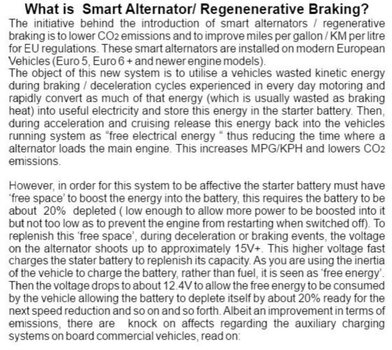Won't you disconnect the battery whilst it is in the container?I’m very confident that what Ineos told me is correct. My vehicle will be in a container for 5 to 6 weeks as of next week on its way to Cape Town that will be a good test as to whether the auxiliary battery will help start the engine. I will make sure the batteries get a good maintenance charge before hand.
My inquiry to Ctek got a reply saying the red wire can be connected if adding the D250SE. .
Someone on this forum from Bell Auto Services has installed a D250 SE lets see if we can find out his wiring set up.
The Grenadier Forum
Register a free account today to become a member! Once signed in, you'll be able to contribute to the community by adding your own topics, posts, and connect with other members through your own private inbox! INEOS Agents, Dealers or Commercial vendors please use the contact us link at the bottom of the page.
-
Guest submit your best shot for a chance to win the December Photo Contest. Photo Contest Click Here
You are using an out of date browser. It may not display this or other websites correctly.
You should upgrade or use an alternative browser.
You should upgrade or use an alternative browser.
Removing the underseat trim panels / accessing or removing the batteries
You're definitely going to want to remove all the covers around the battery before it goes into the container, if you're disconnecting the battery. Actually, I would recommend it either way, just in case you need to access the battery itself. Doing so with the rear doors shut (assuming it isn't a 2 seater) is a huge painWon't you disconnect the battery whilst it is in the container?
No as my vehicle will be full and accessing the batteries then repacking whilst the vehicle is in the container would be a pain. When shipping my defender I relied on the dual battery system with split charger to get me started and worked OK. If it needs a jump start the other end then so be it. I figure some of the Grenadiers have been sat around in holding yards for weeks on end and still start OK albeit needing a good maintenance charge.Won't you disconnect the battery whilst it is in the container?
…I have wondered if the cars’ transport mode, or pre-delivery setup reduces the quiescent current draw; this might account for the state of charge after a long delivery, versus the state after a few days of no driving.
just a thought.
just a thought.
I’ve got a Noco boost starter and jump leads behind the seat if needed.Either way, a jump start is probably your worst outcome, no biggie if you then drive a bit.
i have to correct my earlier statement, I have found some documentation in CTEK manual that the 120 does have built in trickle charging of the starter battery.That’s why I couldn’t find it in the Grenadier manual then. I thought I was going mad. Thanks for that I’ll sleep easier now.
so in effect... you could end up with two relatively flat batteries unable to start the car....Sorry I have found some documentation in CTEK manual that the 120 does have built in trickle charging of the starter battery.
View attachment 7821491
Yes. it Looks like the people with the aux battery should move all their “long term ignition off, battery demand” to the consumer output on the 120 or directly to the aux battery, to draw down the aux battery first not the starter or this trickle charging feature will kick in and draw down the aux battery as well.so in effect... you could end up with two relatively flat batteries unable to start the car....
Last edited:
Thank you this has been my thoughts since issues arisedYes. it Looks like the people with the aux battery should move all their “long term ignition off battery demand” to the consumer output on the 120 or directly to the aux battery, to draw down the aux battery first not the starter or this trickle charging feature will kick in and draw down the aux battery as well.
100%Yes. it Looks like the people with the aux battery should move all their “long term ignition off, battery demand” to the consumer output on the 120 or directly to the aux battery, to draw down the aux battery first not the starter or this trickle charging feature will kick in and draw down the aux battery as well.
This is exactly how I thought i was meant to be but too, but I’ve never had a dual battery setup of any type. I have a TM on order and will have to learn all this stuff. Thankfully this place is a great resource.Yes. it Looks like the people with the aux battery should move all their “long term ignition off, battery demand” to the consumer output on the 120 or directly to the aux battery, to draw down the aux battery first not the starter or this trickle charging feature will kick in and draw down the aux battery as well.
Hence the desire to move all the fuses for additional aux wiring/outputs, and internal usb/cig ones onto the aux or ctek at the fuse level.
if someone comes up with a neat way of doing this, I’ll chip in for a case of something nice for documentation!
i can see why ineos needed it standard, because you can order all combinations with and without aux battery extra wiring high load, but if you have the trialmaster bundle it is a bit of a disappointment they couldnt wire it to aux…
if someone comes up with a neat way of doing this, I’ll chip in for a case of something nice for documentation!
i can see why ineos needed it standard, because you can order all combinations with and without aux battery extra wiring high load, but if you have the trialmaster bundle it is a bit of a disappointment they couldnt wire it to aux…
The service battery will only trickle charge the starter if its voltage is higher, and is only designed to cover the small self-discharge of the starter not a fridge load, reason why it only sends 3 sec pulses, which does 3/5ths of bugger all if the starter is down at 50%. Yes it'll continue to do this while the starter voltage is lower but I expect it'd take quite a while to run itself down to 11.5V. The thing is you shouldn't be in this situation in the first place. Ineos do not expect an owner to run a fridge off the 12V socket in the boot, as with other vehicles where the boot socket is typically only live with the engine on. If an owner was intending to run a fridge in the IG the service battery should've been optioned, unless they planned to DIY their own solution.
The correct way to run a fridge in an IG with a Smartpass and service battery is from the Smartpass load terminal but it requires adding a 250SE, as Ctek designed, it also adds 20A on top of the Smartpass's possible 120A so charging is quicker but only in the bulk stage. The Smartpass can't fully charge the service battery on it's own as it can't regulate voltage to correctly charge the battery to 100% float, which is required for battery longevity. Once the charging amps fall to ~20A the Smartpass will drop out and the Ctek takes over to correctly charge the battery to float.
So all this conjecture is irrelevant if it's done the right way. The starter should typically never reach a state where it can't start the vehicle on its own but the service battery is there to assist in the event cabin lights are left on overnight or the 12V sockets/usb are left running something overnight, or the starter starts to age. Any devices such as dashcams, UHF should also be run from the service battery, either from the Smartpass or direct, users choice. I'd use the Smartpass as it lets the 250SE charge the service battery quicker uniterrupted to float while on the move.
The correct way to run a fridge in an IG with a Smartpass and service battery is from the Smartpass load terminal but it requires adding a 250SE, as Ctek designed, it also adds 20A on top of the Smartpass's possible 120A so charging is quicker but only in the bulk stage. The Smartpass can't fully charge the service battery on it's own as it can't regulate voltage to correctly charge the battery to 100% float, which is required for battery longevity. Once the charging amps fall to ~20A the Smartpass will drop out and the Ctek takes over to correctly charge the battery to float.
So all this conjecture is irrelevant if it's done the right way. The starter should typically never reach a state where it can't start the vehicle on its own but the service battery is there to assist in the event cabin lights are left on overnight or the 12V sockets/usb are left running something overnight, or the starter starts to age. Any devices such as dashcams, UHF should also be run from the service battery, either from the Smartpass or direct, users choice. I'd use the Smartpass as it lets the 250SE charge the service battery quicker uniterrupted to float while on the move.
Last edited:
MarkH what are your thoughts about the 'Smart Alternator' red wires? I plan to add the D250SE but not sure about connecting one or both of the red wires or even just leaving them disconnectedThe service battery will only trickle charge the starter if its voltage is higher, and is only designed to cover the small self-discharge of the starter not a fridge load, reason why it only sends 3 sec pulses, which does 3/5ths of bugger all if the starter is down at 50%. Yes it'll continue to do this while the starter voltage is lower but I expect it'd take quite a while to run itself down to 11.5V. The thing is you shouldn't be in this situation in the first place. Ineos do not expect an owner to run a fridge off the 12V socket in the boot, as with other vehicles where the boot socket is typically only live with the engine on. If an owner was intending to run a fridge in the IG the service battery should've been optioned, unless they planned to DIY their own solution.
The correct way to run a fridge in an IG with a Smartpass and service battery is from the Smartpass load terminal but it requires adding a 250SE, as Ctek designed, it also adds 20A on top of the Smartpass's possible 120A so charging is quicker but only in the bulk stage. The Smartpass can't fully charge the service battery on it's own as it can't regulate voltage to correctly charge the battery to 100% float, which is required for battery longevity. Once the charging amps fall to ~20A the Smartpass will drop out and the Ctek takes over to correctly charge the battery to float.
So all this conjecture is irrelevant if it's done the right way. The starter should typically never reach a state where it can't start the vehicle on its own but the service battery is there to assist in the event cabin lights are left on overnight or the 12V sockets/usb are left running something overnight, or the starter starts to age. Any devices such as dashcams, UHF should also be run from the service battery, either from the Smartpass or direct, users choice. I'd use the Smartpass as it lets the 250SE charge the service battery quicker uniterrupted to float while on the move.
I'll have a go.MarkH what are your thoughts about the 'Smart Alternator' red wires? I plan to add the D250SE but not sure about connecting one or both of the red wires or even just leaving them disconnected
My guess is Ineos left the red wire off for the Smartpass (as Ctek likely advised them to) because Ineos & Ctek expect owners with the service battery optioned to fit a Ctek 250SE (which Ctek recommend & Ineos left space for), they assumed we'd all likely be running a fridge etc. This leaves the SP (Smartpass) as a 'dumb' bulk charger and slave to whatever voltage the alternator produces so it'd only be effective when the 105Ah service battery was heavily depleted, which is when you really want it to kick in and boost the 'bulk' charge rate. This is because the service battery's SOC (state of charge) rises as the resistance (& temperature) in the battery rises, the SP then starts to throttle back and eventually drop out completely I suspect, maybe to only a only few amps. This likely happens around 20A charge rate which is where the 20A rated 250SE takes over to finish the job as it *can* regulate the alternators supply voltage to suit the service battery's rising internal resistance & temp. I'd say the 250SE red wire should be connected as per the Ctek manual, no harm in trying and seeing with a clamp meter what's happening with and without the red wire. And it might tell you more about how the vehicle's ECU/BCM is communicating with the setup, if at all.
No real point in connecting the SP's red wire (but you could also maybe try that) as you only need it to assist with bulk charging - the 250SE and say 5A from the SP is typically enough to recharge the service battery after losing say 20-30Ah overnight to the fridge etc. If the service battery is down at say 40-50% SOC (likely most nights) the Smartpass will ramp up and do the heavy lifting until internal resistance & temperature causes it to wind back, this would get the bulk of charge into the battery and from there the 250SE's 20A finishes the job, especially with such a small service battery, 105Ah is a borderline size to run a 40L fridge without solar to assist (more reasons the 250SE is a must fit). I think the Smartpass has primarily been used as a good solution to bridge the batteries, maintain the starter, provide Start Assist - and isolate the loads (fridge etc) by utilising the alternator while on the move allowing the 250SE to operate effectively as a multi-stage charger without interruption - not so much the SP's ability to charge at the 120A especially in this scenario with a small EFB batt (definitely a benefit with a lithium setup though). A simple VSR & 250SE just wouldn't cut it.
If you replaced the EFB service battery with a lithium you don't have the resisitance (or temperature) issues so I'd then likely connect the Smartpass's red wire so you get the full benefit of maximum charge from both units. A 100-200Ah lithium will accept everything you throw at it right up to about 95% SOC so you might see 100A or even more going in depending on the battery's mgmt system (BMS). You'd only need less than an hour of engine time to replenish a lithium service battery.
Last edited:
Thank you Mark for your great answer to my question. Now i need to work out a bracket to mount the 250SEI'll have a go.
My guess is Ineos left the red wire off for the Smartpass (as Ctek likely advised them to) because Ineos & Ctek expect owners with the service battery optioned to fit a Ctek 250SE (which Ctek recommend & Ineos left space for), they assumed we'd all likely be running a fridge etc. This leaves the SP (Smartpass) as a 'dumb' bulk charger and slave to whatever voltage the alternator produces so it'd only be effective when the 105Ah service battery was heavily depleted, which is when you really want it to kick in and boost the 'bulk' charge rate. This is because the service battery's SOC (state of charge) rises as the resistance (& temperature) in the battery rises, the SP then starts to throttle back and eventually drop out completely I suspect, maybe to only a only few amps. This likely happens around 20A charge rate which is where the 20A rated 250SE takes over to finish the job as it *can* regulate the alternators supply voltage to suit the service battery's rising internal resistance & temp. I'd say the 250SE red wire should be connected as per the Ctek manual, no harm in trying and seeing with a clamp meter what's happening with and without the red wire. And it might tell you more about how the vehicle's ECU/BCM is communicating with the setup, if at all.
No real point in connecting the SP's red wire (but you could also maybe try that) as you only need it to assist with bulk charging - the 250SE and say 5A from the SP is typically enough to recharge the service battery after losing say 20-30Ah overnight to the fridge etc. If the service battery is down at say 40-50% SOC (likely most nights) the Smartpass will ramp up and do the heavy lifting until internal resistance & temperature causes it to wind back, this would get the bulk of charge into the battery and from there the 250SE's 20A finishes the job, especially with such a small service battery, 105Ah is a borderline size to run a 40L fridge without solar to assist (more reasons the 250SE is a must fit). I think the Smartpass has primarily been used as a good solution to bridge the batteries, maintain the starter, provide Start Assist - and isolate the loads (fridge etc) by utilising the alternator while on the move allowing the 250SE to operate effectively as a multi-stage charger without interruption - not so much the SP's ability to charge at the 120A especially in this scenario with an small EFB batt (definitely a benefit with a lithium setup though). A simple VSR & 250SE just wouldn't cut it.
If you replaced the EFB service battery with a lithium you don't have the resisitance (or temperature) issues so I'd then likely connect the Smartpass's red wire so you get the full benefit of maximum charge from both units. A 100-200Ah lithium will accept everything you throw at it right up to about 95% SOC so you might see 100A or even more going in depending on the battery's mgmt system (BMS). You'd only need less than an hour of engine time to replenish the service battery.
Wow, on the screen mine shows a voltage rate at times of 14.9, well above the recommended maximum of 14.4v.so in effect... you could end up with two relatively flat batteries unable to start the car....
I wonder if my batteries have been damaged by this higher voltage as the dash rarely shows above 84% charge.?
This explains what's going on.Wow, on the screen mine shows a voltage rate at times of 14.9, well above the recommended maximum of 14.4v.
I wonder if my batteries have been damaged by this higher voltage as the dash rarely shows above 84% charge.?
Attachments
Thanks Mark, but if Ineos have not connected the “smart alternators “ red wire, as on all the twin battery models, would the above scenario still apply?This explains what's going on.




